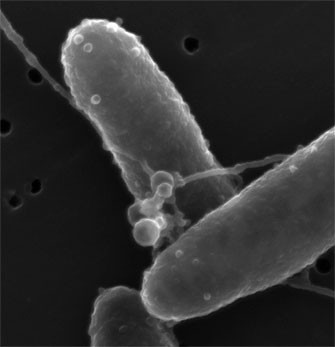Some bacteria grow electrical hair that lets them link up in big biological circuits, according to a University of Southern California biophysicist and his collaborators.
The finding suggests that microbial colonies may survive, communicate and share energy in part through electrically conducting hairs known as bacterial nanowires.
“This is the first measurement of electron transport along biological nanowires produced by bacteria,” said Mohamed El-Naggar, assistant professor of physics and astronomy at the USC College of Letters, Arts and Sciences.
El-Naggar was the lead author of a study appearing online in Proceedings of the National Academy of Sciences.
Knowing how microbial communities thrive is the first step in finding ways to destroy harmful colonies, such as biofilms on teeth. Biofilms have proven highly resistant to antibiotics.
The same knowledge could help to promote useful colonies, such as those in bacterial fuel cells under development at USC and other institutions.
“The flow of electrons in various directions is intimately tied to the metabolic status of different parts of the biofilm,” El-Naggar said. “Bacterial nanowires can provide the necessary links … for the survival of a microbial circuit.”
A bacterial nanowire looks like a long hair sticking out of a microbe’s body. Like human hair, it consists mostly of protein.
To test the conductivity of nanowires, the researchers grew cultures of Shewanella oneidensis MR-1, a microbe previously discovered by co-author Kenneth Nealson, Wrigley Professor of Geobiology at USC College.
Shewanella tend to make nanowires in times of scarcity. By manipulating growing conditions, the researchers produced bacteria with plentiful nanowires.
The bacteria then were deposited on a surface dotted with microscopic electrodes. When a nanowire fell across two electrodes, it closed the circuit, enabling a flow of measurable current. The conductivity was similar to that of a semiconductor — modest but significant.
When the researchers cut the nanowire, the flow of current stopped.
Previous studies showed that electrons could move across a nanowire, which did not prove that nanowires conducted electrons along their length.
El-Naggar’s group is the first to carry out this technically difficult but more telling experiment.
Electricity carried on nanowires may be a lifeline. Bacteria respire by losing electrons to an acceptor — for Shewanella, a metal such as iron. (Breathing is a special case: Humans respire by giving up electrons to oxygen, one of the most powerful electron acceptors.)
Nealson said of Shewanella: “If you don’t give it an electron acceptor, it dies. It dies pretty rapidly.”
In some cases, a nanowire may be a microbe’s only means of dumping electrons.
When an electron acceptor is scarce nearby, nanowires may help bacteria to support each other and extend their collective reach to distant sources.
The researchers noted that Shewanella attach to electron acceptors as well as to each other, forming a colony in which every member should be able to respire through a chain of nanowires.
“This would be basically a community response to transfer electrons,” El-Naggar explained. “It would be a form of cooperative breathing.”
El-Naggar and his team are among the pioneers in a young discipline. The term “bacterial nanowire” was coined in 2006. Fewer than 10 studies on the subject have been published, according to co-author Yuri Gorby of The J. Craig Venter Institute in San Diego, discoverer of nanowires in Shewanella.
Gorby and others became interested in nanowires when they noticed that reduction of metals appeared to be occurring around the filaments. Since reduction requires the transfer of electrons to a metal, the researchers suspected that the filaments were carrying a current.
Nanowires also have been proposed as conductive pathways in several diverse microbes.
“The current hypothesis is that bacterial nanowires are in fact widespread in the microbial world,” El-Naggar said.
Some have suggested that nanowires may help bacteria to communicate as well as to respire.
Bacterial colonies are known to share information through the slow diffusion of signaling molecules. Nealson argued that electron transport over nanowires would be faster and preferable for bacteria.
“You want the telegraph, you don’t want smoke signals,” he said.
Bacteria’s communal strategy for survival may hold lessons for higher life forms.
In an op-ed published in Wired in 2009, Gorby wrote: “Understanding the strategies for efficient energy distribution and communication in the oldest organisms on the planet may serve as useful analogies of sustainability within our own species.”
In addition to El-Naggar, Gorby and Nealson, the study’s authors were Thomas Yuzvinsky of USC College; Greg Wanger of The J. Craig Venter Institute; and Kar Man Leung, Gordon Southam, Jun Yang and Woon Ming Lau from the University of Western Ontario.
Funding for the research came from the Air Force Office of Scientific Research, the U.S. Department of Energy, the Legler-Benbough Foundation, the J. Craig Venter Institute, the Canadian Natural Science and Engineering Research Council, the Canada Foundation for Innovation and Surface Science Western.
Story Source:
The above story is reprinted from materials provided by University of Southern California. The original article was written by Carl Marziali.





